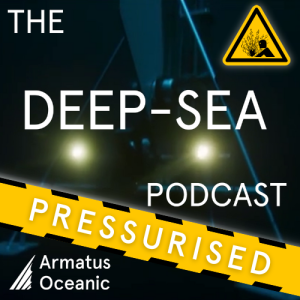
Our short and to the point PRESSURISED version of episode 37. If you don't have time for the full episode and want to get right to the science without any of our waffle, this is the place to be!
Read the show notes and find the full episode here:
https://www.armatusoceanic.com/podcast/037-deep-digging
Alan is somewhere in the middle of the Pacific Ocean and Thom has been dissecting fish left right and centre at Te Papa. What better time to talk about deep-sea digging?
After the exciting news last month about the geological cruise that drilled through the Moho (the area where the Earth’s crust meets the mantle), we thought it would be interesting to talk with Andrew McCaig, the co-chief scientist for that expedition. Andrew talks us through the expedition's goals, achievements and the drilling process itself. Why were geologists interested in reaching this area and what exactly is serpentinisation?
We’re really trying to make this project self-sustaining so we have started looking for ways to support the podcast. Here’s a link to our page on how to support us, from the free options to becoming a patron of the show. And we want to thank our most recent patrons:
Tammy Frank | Martin Pollizotto | Ray M | Nicole Vite-Liebl | Anna P | Eric
Thanks again for tuning in, we’ll deep-see you next time!
Check out our podcast merch here! Which now includes Alan’s beloved apron and a much anticipated new design...
Feel free to get in touch with us with questions or your own tales from the high seas on:
podcast@armatusoceanic.com
We’d love to actually play your voice so feel free to record a short audio note!
We are also on
Twitter: @DeepSeaPod, @ArmatusO
Facebook: DeepSeaPodcast, ArmatusOceanic
Instagram: @deepsea_podcast, @armatusoceanic
Keep up with the team on social media
Twitter:
Alan - @Hadalbloke (https://twitter.com/Hadalbloke)
Thom - @ThomLinley (https://twitter.com/ThomLinley)
Georgia - @geeinthesea (https://twitter.com/geeinthesea)
Instagram:
Georgia - @geeinthesea (https://www.instagram.com/geeinthesea/)
Read the show notes and find out more about us at:
Glossary
Archaea - Microorganisms similar to bacteria in size and simplicity, but are very different molecularly. They’re thought to be the ancient intermediate group between bacteria and eukaryotes.
Astrophysics - Astrophysics is a branch of space science that applies the laws of physics and chemistry to seek to understand the universe.
Atlantis massif - An underwater mountain in the Atlantic Ocean.
Core barrel - A plastic tube which collects the rock core from drilling into the sediment.
Core samples - A long column of rock obtained by drilling into sediment or rock with a hollow steel tube.
Deep biosphere - The expansive ecosystem of microbes which exist deep under the seabed.
Derrick (on a ship) - A machine that is used to move things on a ship (similar to a crane).
Drill cone - A tool which can crush rocks during the drilling process.
Drill pipe - A hollow pipe used in drilling projects.
Fault - A fracture or discontinuity in an area of rock because of big movements in the rock.
Geochemistry - The study of the chemistry of geological materials such as rock, sediment, soil and water.
Goblin shark - A species of deep-sea shark with a retractable jaw.
IODP - International ocean discovery program.
JOIDES Resolution - A drilling ship used by the IODP.
Kaharoa - (RV Kaharoa) Research vessel owned by NIWA in New Zealand. Thom and Alan have conducted many expeditions from this vessel.
Lost city hydrothermal field - An area of hydrothermal vents on the Atlantis Massif, in the Atlantic Ocean.
Magnetite - Magnetite is a mineral and one of the main iron ores.
Moho - Mohorovicic Discontinuity, or "Moho," is the boundary between the crust and the mantle.
Narcomedusae - A type of hydrozoan (a gelatinous cnidarian similar to jellyfish).
NIWA - (National Institute of Water and Atmospheric Research) based in Auckland, New Zealand.
Olivine - The primary component of the Earth's upper mantle, it is a common mineral in Earth's subsurface, but weathers quickly on the surface.
Peridotite - is a dense, coarse-grained igneous rock consisting mostly of the silicate minerals olivine and pyroxene. Most of the mantle is made up of this rock.
Petrology - The branch of geology which explores the compositions, structures and origins of rocks.
Serpentine - Hydrated version of Olivine. Serpentine is a group of minerals that are usually green in colour.
Serpentinisation - The process of minerals such as olivine becoming serpentine.
Shear zones - A zone in the Earth’s crust or upper mantle that has been deformed due to the walls of rock on either side slipping past each other.
Structural geology - The branch of geology which explored the form, arrangement and internal structure of rocks.
Sunfish (Mola mola) - One of the largest bony fish in the world.
Links
Andrew McCaig’s University of Leeds bio
Credits
Theme – Hadal Zone Express by Märvel
Logo image: Johan Swanepoel
#Podcast #scicomm #Science #MarineBiology #DeepSea #DeepOcean #AlanJamieson #discovery #Exp399 #AndrewMcCaig #JOIDESresolution #IODP #marinedrilling #deepseadrilling #geology #marinegeology #mantle #petrology #noho #serpentinization #atlantismassif #lostcity #biosphere #microbes #microbialecology #coldseeps #archaea #bacteria #fungi #hydrothermalvents #deepseaspecies #scicomm #deepseacreatures
No comments yet. Be the first to say something!